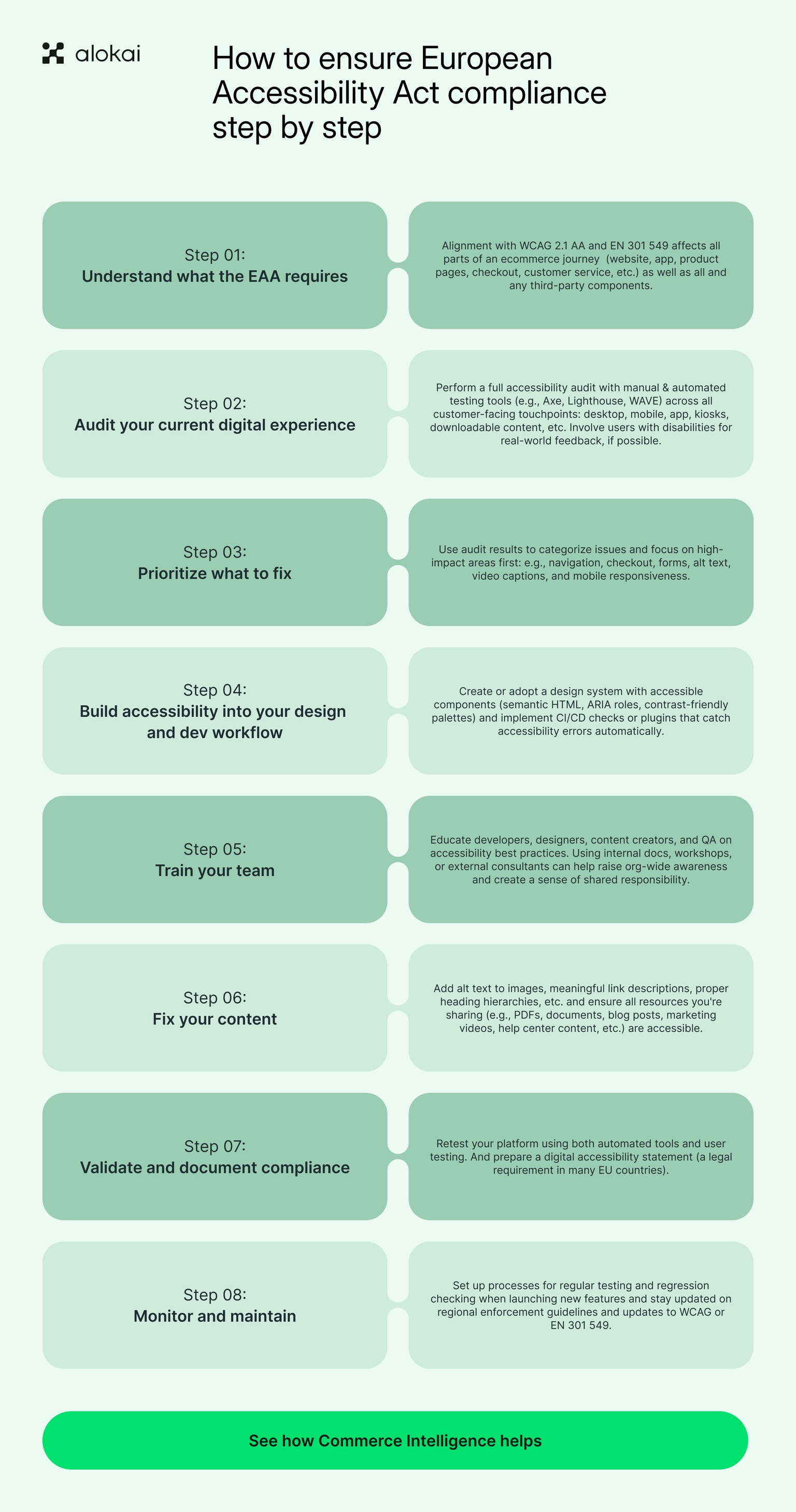The European Accessibility Act (EAA) is about to take full effect this summer, and it means some significant changes for ecommerce companies operating in the EU. Even if your business isn’t headquartered in the EU but you’re running the business within the EU, these changes may significantly affect your operations. European Accessibility Act compliance is essential to meet specific requirements and obligations, including technical standards and organizational practices.
We’ve gathered all the crucial updates in one post to help you prepare.
TL;DR: What’s EAA all about?
Effective June 28, 2025, the EAA requires all digital products and services sold in the EU to be accessible to people with disabilities.
Applies to any business selling in the EU, regardless of where it’s headquartered.
Non-compliance can cost up to €500,000 in fines (varies by country), plus public enforcement or daily penalties.
Accessibility improves UX, conversion rates, and SEO, benefiting all users, not just those with disabilities.
It also future-proofs your tech stack for global regulations, reduces legal risk, and aligns with composable and API-first strategies.
And now let’s get into the specifics!
Introduction to the Accessibility Act
The European Accessibility Act (EAA) is a directive adopted by the European Union to improve the accessibility of key products and services. The EAA aims to ensure equal access for people with disabilities by setting common accessibility requirements across all EU member states. This act applies to digital products and services, including e-commerce websites, banking, transportation, and more. The EAA requires that websites, mobile apps, and digital tools be accessible to people with disabilities, following widely recognized standards such as the Web Content Accessibility Guidelines (WCAG).
Everything you need to know about the EAA changes
Starting June 28, 2025, the European Accessibility Act will become fully enforceable across EU member states, emphasizing the importance of adhering to the EAA's requirements. EAA compliance is crucial for businesses to ensure inclusivity, avoid legal repercussions, and potentially enhance search engine rankings. This legislation mandates that key digital products and services—including ecommerce websites, mobile apps, self-service terminals, and electronic communications platforms—must be accessible to people with disabilities.
Who is affected by the EAA?
The European Accessibility Act applies to any business that offers products or services in the EU market, regardless of where that business is based. That means:
If your company is registered in an EU member state, compliance is mandatory.
If your company is not based in the EU (e.g., headquartered in the US or UK) but you sell to customers in the EU, the law still applies to you.
- B2C, B2B, and B2G (business-to-government) companies need to comply.
In other words, the law is enforced based on market presence, not company headquarters.
If you're offering ecommerce services, digital products, or customer interactions to users within the EU, you’re expected to meet the same accessibility requirements as EU-based companies.
This mirrors the approach of other EU regulations like the GDPR, which also applies extraterritorially. The goal is to protect EU consumers, not to regulate by origin.
Scope and Application
The EAA has a broad scope, covering various products and services, including equipment with computer capability, point of sale devices, self-service transaction machines, and services offered through websites and mobile apps. The act applies to all businesses operating within the EU, except those with under 10 employees. The EAA’s accessibility requirements are designed to ensure that people with disabilities have equal access to products and services, and that businesses comply with the European Union’s accessibility standards.
Who is affected by the EAA?
The European Accessibility Act, adopted by individual EU nations starting in 2022, applies to any business that offers products or services in the EU market, regardless of where that business is based. That means:
- If your company is registered in an EU member state, compliance is mandatory.
- If your company is not based in the EU (e.g., headquartered in the US or UK) but you sell to customers in the EU, the law still applies to you.
- B2C, B2B, and B2G (business-to-government) companies need to comply.
Failure to comply with the EAA can lead to severe consequences of non-compliance, including hefty fines, removal of products from the market, and suspension of business rights.
In other words, the law is enforced based on market presence, not company headquarters.
If you’re offering ecommerce services, digital products, or customer interactions to users within the EU, you’re expected to meet the same accessibility requirements as EU-based companies.
This mirrors the approach of other EU regulations like the GDPR , which also applies extraterritorially. The goal is to protect EU consumers, not to regulate by origin.
What does the EAA entail for ecommerce businesses?
Websites and apps must meet recognized accessibility standards (like WCAG 2.1 Level AA and EN 301 549).
All digital touchpoints (e.g., checkout systems or customer service chats) must be easy to use for people with visual, hearing, motor, or cognitive impairments.
Accessibility is no longer optional: it’s a legal requirement for selling into the EU market.
Third-party services (e.g., payment providers, search, or product review tools) integrated into your stack must also comply.
Fines and penalties vary by country, but can reach €500,000 or more, and may include public notices of non-compliance, daily fines, or legal action.
The EAA is part of a broader EU strategy (2021–2030) to ensure equal access to products and services for everyone. It aims to harmonize accessibility rules across Europe, making it easier for companies to operate across borders—but only if they meet the new standards.
In short: If your digital commerce experience isn’t accessible by default, it won’t be compliant by 2025.
.png?width=768&auto=webp&format=pjpg&disable=upscale&quality=100&dpr=2)
What does “accessibility” mean exactly in this context?
Here are some crucial examples of website accessibility based on WCAG 2.1 Level AA and EN 301 549 regulations:
Keyboard navigation: Your site/app must work without a mouse
Screen reader compatibility: Text and content must be properly coded so that assistive technologies can read them aloud
Alt text for images: Descriptive text must be added to all visual content, and not just for SEO.
Clear, consistent structure: Use proper headings, labels, and layouts so users can understand and navigate easily
Sufficient color contrast: Text must be readable against background colors
Accessible PDFs and downloads: Documents and product manuals must follow accessibility formatting
Captioned videos: Multimedia content should include subtitles or transcripts
Error messages and forms: Forms must clearly indicate errors and how to fix them, and be operable by all users
Organizations that fail to comply with the European Accessibility Act (EAA) face significant penalties, including steep fines and market removal. Compliance is essential for all businesses operating within the EU, not just public-sector organizations.
What are the penalties for non-compliance?
Non-compliance is more expensive than action. As an enterprise decision-maker, you already understand the importance of risk mitigation. Fines for failing to meet accessibility standards can reach up to €500,000 depending on the country.
While the EAA sets the framework, enforcement and penalties are determined by individual EU member states:
🇩🇪 Germany: Fines up to €500,000 for non-compliance.
🇫🇷 France: Fines ranging from €5,000 to €250,000, with potential public disclosure of non-compliance.
🇪🇸 Spain: Fines between €5,000 and €300,000, depending on the severity of the violation
🇮🇪 Ireland: Fines up to €60,000 and/or imprisonment for up to 18 months for severe non-compliance.
Additionally, ongoing non-compliance can result in daily fines of up to €1,000 until issues are resolved.
Compliance with the European Regulations
Compliance with the European Accessibility Act is crucial for businesses operating in the EU. The EAA requires businesses to ensure that their products and services meet specific accessibility requirements, including digital accessibility. This involves implementing accessibility standards, such as the Web Content Accessibility Guidelines (WCAG), and ensuring that websites and mobile apps are accessible to people with disabilities. Businesses must also publish accessibility statements indicating how they meet the EAA’s accessibility requirements.
The impact of European Accessibility Act 2025 on ecommerce businesses
It may seem like a lot, but the truth is that your website is already likely to be accessible and compliant, simply because it comes with some critical benefits. Namely: improved user experience and future-proof tech stack. You wouldn’t say no to that, would you?
More than 80 million people in the EU are affected by disability to some degree. In the terms of ensuring accessibility terms for business, it's 80+ million of potential customers you may be losing by failing to meet compliance.
A promise of improved digital experience
Accessibility benefits everyone, not just people with permanent disabilities. The design and development practices required for accessibility are often the same ones that lead to cleaner interfaces, faster navigation, and more intuitive interactions.
Making your site more navigable, clearer, and easier to use enhances the experience for all of them and improves performance while at it:
Clearer structure and navigation (such as logical headings, consistent layout, and clear labels) make it easier for users to scan and navigate your site efficiently.
Better readability achieved through sufficient color contrast makes text easier to read in bright sunlight, on low-quality monitors, or for users with temporary vision fatigue.
Alternative text for images supports screen readers and helps when images don’t load, improves SEO, and benefits users on slower connections.
Captions and transcripts added to videos benefit Deaf and hard-of-hearing users, as well as anyone watching without sound, like commuters, night-time scrollers, or non-native speakers.
Accessible forms = smoother checkout resulting in lower cart abandonment rates.
Older users navigating age-related vision or motor changes, mobile users trying to shop on-the-go, someone recovering from surgery and relying on voice control—these are all real users your business serves. And EAA makes it a more pleasant and easier experience for everybody!
Accessibility compliance = future-proofing your technology
The EAA is just one example in a global trend: Canada’s Accessible Canada Act is already in place, and ADA enforcement in the U.S. continues to accelerate. We’re also seeing accessibility becoming a requirement in procurement contracts, public tenders, and even B2B partnership deals.
Here are just a few ways how accessibility helps you future-proof your tech stack:
Proactively meeting accessibility standards reduces your exposure to lawsuits, penalties, and enforcement actions, many of which are increasing in volume and severity, especially in regions like the U.S. and EU.
Accessible platforms are, by necessity, cleanly coded and standards-compliant. That means they play better with assistive technologies and third-party integrations, making it easier to scale or swap parts of your composable stack later.
When accessibility is planned (rather than added as an afterthought) it leads to cleaner code, better documentation, and easier testing over time. This reduces technical debt and improves developer efficiency.
Accessibility best practices (like semantic HTML, structured content, and decoupled interfaces) align naturally with API-first, headless, and composable approaches. That means your frontend remains flexible and ready for omnichannel delivery.
A future-proof stack isn’t just about code—it’s about brand reputation, audience reach, and adaptability. Accessibility reinforces trust, inclusivity, and global readiness—all key assets for enterprise ecommerce growth.
Make your ecommerce website compliant step by step
Conduct an accessibility audit: Evaluate your digital platforms to identify areas that do not meet accessibility standards.
Develop a remediation plan: Prioritize issues based on severity and impact, and outline steps to address them.
Implement missing accessibility features: Incorporate necessary changes, such as adding alt text to images, ensuring keyboard navigability, and enhancing color contrast.
Train your team: Educate developers, designers, and content creators on accessibility best practices to maintain compliance. Develop a style or brand guide if necessary.
Monitor and maintain: Regularly review your platforms to ensure ongoing compliance, especially when adding new features or content. Alokai’s Commerce Intelligence, for example, allows you to do that almost automatically!

Pro tips for ensuring accessibility compliance
✅ Choose vendors and third-party tools that are accessibility-compliant to avoid issues in the future
✅ Consider hiring a certified accessibility consultant or agency to accelerate progress if unsure of any of the steps
✅ Don’t wait for enforcement—accessibility takes time to implement well, so if you’re just getting started with it now, chances are you’ll be running a little too late.
Ensuring eaa compliance is crucial for businesses operating within the EU to create inclusive digital experiences and avoid legal repercussions.
The point is: the goal behind EAA is not to scare or discourage businesses from operating in the European Union. It’s about building better customer experience for as many users as possible. Adhering to eaa standards is essential, as it often becomes a requirement for government and private sector contracts. Continuously monitoring and maintaining website accessibility ensures ongoing compliance, especially after design changes or regulatory updates.
We could tell you that composable commerce helps with introducing changes to your frontend faster and easier. But you already know that, right?













